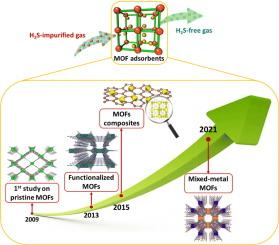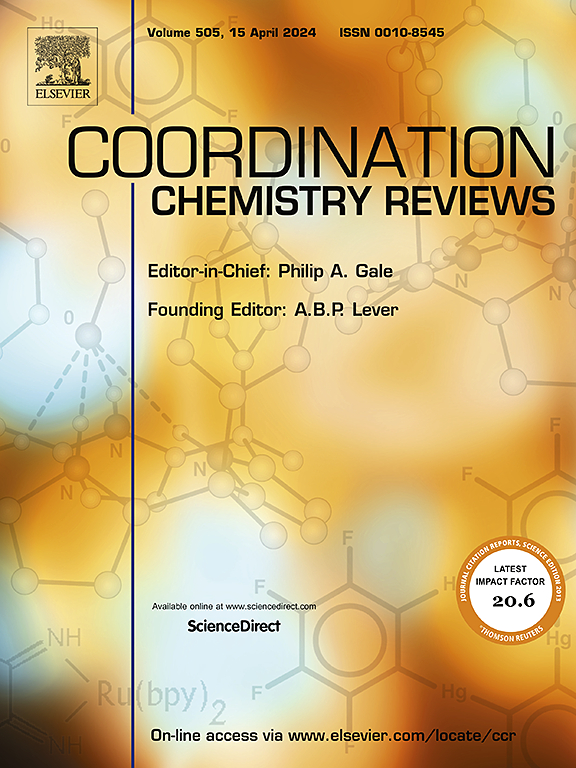基于金属有机框架的H2S去除系统的发展:综合综述
IF 20.3
1区 化学
Q1 CHEMISTRY, INORGANIC & NUCLEAR
引用次数: 0
摘要
沼气是公认的可再生能源,可以替代化石燃料,特别是天然气。沼气是由多种有机资源产生的,主要含有甲烷(CH4)和二氧化碳(CO2)。然而,在沼气流中发现了几种污染物,如硫化氢(H2S)、水(H2O)、氨(NH3)和挥发性有机化合物(VOCs)。其中,由于H2S具有较高的腐蚀性、毒性和难闻的气味,必须首先集中清除,避免设备损坏和健康风险。在H2S脱除技术中,固体吸附剂被认为是一种友好有效的脱除方法。近年来,金属-有机框架(MOFs)因其高比表面积、良好的热稳定性和结构可调性而受到越来越多的关注。尽管许多基于mofs的系统都是为去除H2S而设计的,但对它们进行深入总结的研究却很少。这项工作旨在修订文献中基于MOFs的H2S去除网络的发展,包括原始MOFs、功能化MOFs、MOF复合材料和混合金属MOFs。我们重点解释了mof对H2S的吸附机理,以及直接影响其对H2S吸附能力、对其他气体的选择性和再生能力的材料工程因素。此外,还提出了几种提高mof去除性能的方法。综上所述,本研究将为mof衍生的H2S吸附剂的当前技术和发展前景提供一个全面的文件。本文章由计算机程序翻译,如有差异,请以英文原文为准。


Development of metal-organic framework-based systems for H2S removal: A comprehensive review
Biogas is recognized as a source of renewable energy that can substitute for fossil fuels, especially natural gas. Biogas is produced from various organic resources, and it contains mainly methane (CH4) and carbon dioxide (CO2). However, several contaminants are found in the biogas flow such as hydrogen sulfide (H2S), water (H2O), ammonia (NH3), and volatile organic compounds (VOCs). Therein, due to its high corrosion, toxicity, and bad odor, H2S must be eliminated first and intensively to avoid equipment damage and health risks. Among H2S removal technologies, using the solid adsorbent is viewed as a friendly and effective way. Recently, metal-organic frameworks (MOFs) have been studied with increasing attention for H2S adsorption thanks to their high surface area, good thermal stability and structural tunability. Although many MOFs-based systems have been designed for H2S removal, an intensive study to summarize them is missing. This work aims to revise the development of MOFs-based networks for H2S removal in literature including pristine MOFs, functionalized MOFs, MOF composites, and mixed-metal MOFs. We focus on explaining H2S adsorption mechanism of MOFs, and material engineering factors that directly affect the H2S adsorption capacity, the selectivity over other gases, and the ability to regenerate. Furthermore, several perspectives to enhance the removal performance of MOFs are also proposed. Together, this study will provide a comprehensive document on current technologies and perspective development of MOF-derived H2S adsorbent.
求助全文
通过发布文献求助,成功后即可免费获取论文全文。
去求助
来源期刊

Coordination Chemistry Reviews
化学-无机化学与核化学
CiteScore
34.30
自引率
5.30%
发文量
457
审稿时长
54 days
期刊介绍:
Coordination Chemistry Reviews offers rapid publication of review articles on current and significant topics in coordination chemistry, encompassing organometallic, supramolecular, theoretical, and bioinorganic chemistry. It also covers catalysis, materials chemistry, and metal-organic frameworks from a coordination chemistry perspective. Reviews summarize recent developments or discuss specific techniques, welcoming contributions from both established and emerging researchers.
The journal releases special issues on timely subjects, including those featuring contributions from specific regions or conferences. Occasional full-length book articles are also featured. Additionally, special volumes cover annual reviews of main group chemistry, transition metal group chemistry, and organometallic chemistry. These comprehensive reviews are vital resources for those engaged in coordination chemistry, further establishing Coordination Chemistry Reviews as a hub for insightful surveys in inorganic and physical inorganic chemistry.
 求助内容:
求助内容: 应助结果提醒方式:
应助结果提醒方式:


